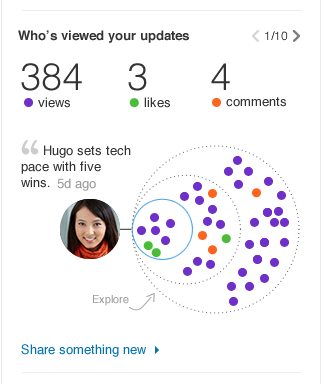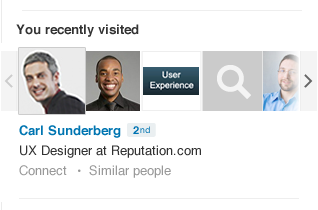LinkedIn, the social network used by people for job hunting and making other business connections, is adding two more enhancements to its homepage that highlight one of its more unnerving, but occasionally useful, elements: how it tracks what people visit on the site and then reports on that activity.
From today, it will start showing users who has viewed not just their overall profiles, but also their updates on the site; and it will also start showing what you’ve been visiting yourself. Together, the two build on a long-standing feature on LinkedIn’s homepage, “Who’s viewed your profile,” and they also underscore how LinkedIn continues to add services to encourage more activity on its platform.
The bigger picture, too, is that LinkedIn is fighting another trend: that of declining revenue growth. While actual sales are still on the rise, and even exceeding expectations in recent quarters, the overall trend is one of growth on the site slowing. In that context, the hope is that adding new features to increase activity on LinkedIn will drive more paid users, as well as more advertising.
 “Who’s viewed your updates” differs from the existing profile viewing tracker in a couple of ways. For starters, there is no paygate on the feature that limits how much data you can see. In comparison, LinkedIn uses its profile view as a way to drive paid subscriptions to the service: you receive a limited list of those who have looked up your profile; you cannot see a full list, or who is seeing your name in searches, unless you “unlock the full list with LinkedIn Premium.”
“Who’s viewed your updates” differs from the existing profile viewing tracker in a couple of ways. For starters, there is no paygate on the feature that limits how much data you can see. In comparison, LinkedIn uses its profile view as a way to drive paid subscriptions to the service: you receive a limited list of those who have looked up your profile; you cannot see a full list, or who is seeing your name in searches, unless you “unlock the full list with LinkedIn Premium.”
LinkedIn tells me it has no plans to charge for “who’s viewed your updates,” perhaps because it wants to push the site as a platform for sharing content. To that end, it shows how much specific status updates and shared news gets viewed, liked and commented on, and by whom, and whether those people are in your first, second or third circle of contacts.
This, in turn, not only serves as a reminder to people to keep updating their accounts — “Share something new,” the box notes — but like the profile view, seeing who has been responding to your status updates is a way for you to make new contacts or revisit existing ones. (And also like the profile view, in my opinion it’s a slightly creepy reminder that you are being watched wherever you go on the site.)
“Who’s viewed your updates” also highlights LinkedIn’s wider social media ambitions. The concentric circles and datapoints about comments, likes and views speaks to how the site is, bit by bit, offering more analytics tools to its users, particularly those who look to the site as a marketing platform either for themselves or for their businesses.
 “You recently visited” is another play on analytics, but this time focusing on you. It tracks personal profiles that you’ve viewed, searches you have made, and group discussions where you have contributed. Down the line, LinkedIn tells me it will also include articles you have seen and company profiles.
“You recently visited” is another play on analytics, but this time focusing on you. It tracks personal profiles that you’ve viewed, searches you have made, and group discussions where you have contributed. Down the line, LinkedIn tells me it will also include articles you have seen and company profiles.
“This makes it easier to retrace your steps, re-engage in conversations or follow-up with that old colleague you intended to connect with,” writes Caroline Gaffney, Homepage product lead at LinkedIn in a post that will soon be posted on the company’s blog.
Again, this highlights LinkedIn as a place for research, and if you use it a lot, it can be a simple way to track what you’ve done in case you need to return to something. Like the other new feature, LinkedIn tells me there are no plans for now to charge for this.
Today’s two new features are the latest additions to LinkedIn’s homepage, which it first started to update about a year ago. They will start appearing in that all-important right-hand column, where the profile viewing data, advertising, new contact suggestions and other high-priority features are placed.
Altogether, these features are part of a much bigger platform refresh at LinkedIn that has seen the site move to more updated, interactive features across the board. These have included the ability to add photos, presentations and other media to your profile; an update to the Contacts page to add in more “personal assistant” life organizing features; new iPhone and Android apps; an expanded search engine; @mentions in status updates; Klout-style endorsements; and a Recruiter homepage redesign for the site’s most dedicated user vertical.
Gaffney notes that there will be more updates coming soon.